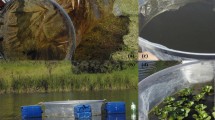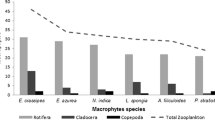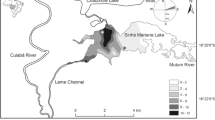Abstract
Several studies have shown that submerged macrophytes provide a refuge for zooplankton against fish predation, whereas the role of emergent and floating-leaved species, which are often dominant in eutrophic turbid lakes, is far less investigated. Zooplankton density in open water and amongst emergent and floating-leaved vegetation was monitored in a small, eutrophic lake (Frederiksborg Slotssø) in Denmark during July–October 2006. Emergent and floating-leaved macrophytes harboured significantly higher densities of pelagic as well as plant-associated zooplankton species, compared to the open water, even during periods where the predation pressure was presumably high (during the recruitment of 0+ fish fry). Zooplankton abundance in open water and among vegetation exhibited low values in July and peaked in August. Bosmina and Ceriodaphnia dominated the zooplankton community in the littoral vegetated areas (up to 4,400 ind l−1 among Phragmites australis and 11,000 ind l−1 between Polygonum amphibium stands), whereas the dominant species in the pelagic were Daphnia (up to 67 ind l−1) and Cyclops (41 ind l−1). The zooplankton density pattern observed was probably a consequence of concomitant modifications in the predation pressure, refuge availability and concentration of cyanobacteria in the lake. It is suggested that emergent and floating-leaved macrophytes may play an important role in enhancing water clarity due to increased grazing pressure by zooplankton migrating into the plant stands. As a consequence, especially in turbid lakes, the ecological role of these functional types of vegetation, and not merely that of submerged macrophyte species, should be taken into consideration.





Similar content being viewed by others
References
Andersen, J. M. & O. S. Jacobsen, 1979. Production and decomposition of organic matter in eutrophic Frederiksborg Slotssø, Denmark. Archiv Für Hydrobiologie 85: 511–542.
Burks, R. L., D. M. Lodge, E. Jeppesen, et al., 2002. Diel horizontal migration of zooplankton: costs and benefits of inhabiting the littoral. Freshwater Biology 47: 343–365.
Burks, R. L., G. Mulderij, E. Gross, et al., 2006. Center stage: the crucial role of macrophytes in regulating trophic interactions in shallow lake wetlands. In Bobbink, R., J. T. A. Verhoeven & D. E. Whigham (eds), Wetlands: functioning, biodiversity conservation, and restoration. Springer-Verlag, Berlin, Germany: 37–59.
Canfield, D., E. J. V. Shireman, D. E. Colle, et al., 1984. Prediction of chlorophyll a concentrations in Florida lakes—importance of aquatic macrophytes. Canadian Journal of Fisheries and Aquatic Sciences 41: 497–501.
Carpenter, S. R., J. F. Kitchell & J. R. Hodgson, 1985. Cascading trophic interactions and lake productivity. Bioscience 35: 634–639.
Christoffersen K., 1990. Evaluation of Chaoborus predation on natural populations of herbivorous zooplankton in a eutrophic lake. Hydrobiologia 200: 459–466.
Christoffersen K., 1996. Ecological implications of cyanobacterial toxins in aquatic food webs. Phycologia 35: 42–50.
Christoffersen, K., B. Riemann, A. Klysner, et al., 1993. Potential role of fish predation and natural populations of zooplankton in structuring a plankton community in eutrophic lake water. Limnology and Oceanography 38: 561–573.
Cryer, M., G. Peirson & C. R. Townsend, 1986. Reciprocal interactions between roach, Rutilus rutilus, and zooplankton in a small lake—prey dynamics and fish growth and recruitment. Limnology and Oceanography 31: 1022–1038.
Jeppesen, E., T. L. Lauridsen, T. Kairesalo, M. R. Perrow, 1998. Impact of submerged macrophytes on fish–zooplankton interactions in lakes. In Jeppesen, E., Ma. Søndergaard, Mo. Søndergaard & K Christoffersen (eds), The structuring role of submerged macrophytes in lakes. Springer-Verlag, NY, USA: 91–114.
Jeppesen, E., Z. Pekcan-Hekim, T. L. Lauridsen, et al., 2006. Habitat distribution of fish in late summer: changes along a nutrient gradient in Danish lakes. Ecology of Freshwater Fish 15: 180–190.
Jeppesen, E., M. Søndergaard, M. Meerhoff, et al., 2007a. Shallow lake restoration by nutrient loading reduction—some recent findings and challenges ahead. Hydrobiologia 584: 239–252.
Jeppesen, E., M. Meerhoff, B. A. Jacobsen, et al., 2007b. Restoration of shallow lakes by nutrient control and biomanipulation—the successful strategy varies with lake size and climate. Hydrobiologia 581: 269–285.
Jespersen, A. M. & K. Christoffersen, 1987. Measurements of chlorophyll a from phytoplankton using ethanol as extraction solvent. Archiv Für Hydrobiologie 109: 445–454.
Jespersen, A. M., K. Christoffersen, B. Riemann, 1988. Annual carbon fluxes between phyto-, zoo-, and bacterio-plankton in eutrophic, Lake Frederiksborg Slotssø, Denmark. Verhandlunge, International Verein Limnologie 23: 440–444.
Lauridsen, T. L. & D. M. Lodge, 1996. Avoidance by Daphnia magna of fish and macrophytes: chemical cues and predator mediated use of macrophyte habitat. Limnology and Oceanography 41(4): 794–798.
Lauridsen, T. L., L. J. Pedersen, E. Jeppesen, et al., 1996. The importance of macrophyte bed size for Cladoceran composition and horizontal migration an a shallow lake. Journal of Plankton Research 18: 2283–2294.
Mischke, U., 2003. Cyanobacteria associations in shallow polytrophic lakes: influence of environmental factors. Acta Oecologica International Journal of Ecology 24(Suppl. 1): S11–S23.
Müller, J. P. & Jensen, H. J., 2004. The fish stocks in Frederiksborg Slotssø, September 2004. Internal report (in Danish), 30 pp.
Nurminen, L., J. Horppila & P. Tallberg, 2001. Seasonal development of the Cladoceran assemblage in a turbid lake: the role of emergent macrophytes. Archiv Für Hydrobiologie 151: 127–140.
Nurminen, L., J. Horppila & Z. Pekcan-Hekim, 2007. Effect of light and predator abundance on the habitat choice of plant-attached zooplankton. Freshwater Biology 52: 539–548.
Pennak, R. W., 1966. Structure of zooplankton populations in littoral macrophyte zone of some Colorado lakes. Transactions of the American Microscopical Society 85: 329–349.
Rasmussen, H. U., 2001. Frederiksborg Slotssø, 1999—Vandmiliøovervågning Nr. 85. Frederiksborg Amt, Teknik & Miljø Miljøafdelingen, Frederiksborg County, Denmark (in Danish), 48 pp.
Rohrlack, T., K. Christoffersen, P. E. Hansen, et al., 2003. Isolation, characterization, and quantitative analysis of microviridin J, a new Microcystis metabolite toxic to Daphnia. Journal of Chemical Ecology 29: 1757–1770.
Scheffer, M., S. H. Hosper, M. L. Meijer, et al., 1993. Alternative equilibria in shallow lakes. Trends in Ecology & Evolution 8: 275–279.
Søndergaard, M. & B. Moss, 1998. Impact of submerged macrophytes on phytoplankton in shallow freshwater lakes. In Jeppesen, E., Ma. Søndergaard, Mo. Søndergaard & K. Christoffersen (eds), The structuring role of submerged macrophytes in lakes. Springer Verlag, NY, USA: 115–132.
Stansfield, J. H., M. R. Perrow, L. D. Tench, et al., 1997. Submerged macrophytes as refuges for grazing Cladocera against fish predation: observations on seasonal changes in relation to macrophyte cover and predation pressure. Hydrobiologia 342: 229–240.
Statistica (ver. 6.0), 2003. Statsoft, Scandinavia, Uppsala, Sweden.
Timms, R. M. & B. Moss, 1984. Prevention of growth of potentially dense phytoplankton populations by zooplankton grazing in the presence of zooplanktivorous fish. In: A shallow wetland ecosystem. Limnology and Oceanography 29: 472–486.
Utermöhl, H., 1958. Zur Vervollkommung der quantitatven Phytoplankont-Metodik. Mitt. Unt. Ver. Limnol. 9: 1–38.
Vuille, T., 1991. Abundance, standing crop and production of microcrustacean population (Cladocera, Copepoda) in the littoral zone of lake Biel, Switzerland. Archiv Für Hydrobiologie 123: 165–185.
Winfield, I. J., 1986. The influence of simulated aquatic macrophytes on the zooplankton consumption rate of juvenile roach, Rutilus rutilus, rudd, Scardinius erythrophthalmus, and perch, Perca fluviatilis. Journal of Fish Biology 29(Suppl. A): 37–48.
Winfield, I. J., G. Peirson, M. Cryer, et al., 1983. The behavioural basis of prey selection by under yearling breams (Abramis brama (L.)) and roach (Rutilus rutilus (L.)). Freshwater Biology 13: 139–149.
Acknowledgements
We wish to thank Charlotte Møller and Nils Willumsen, both from the Freshwater Biological Laboratory, for technical assistance and Erik Jeppesen from the National Environmental Research Institute, and two anonymous referees for valuable comments to an earlier version of the manuscript.
Author information
Authors and Affiliations
Corresponding author
Additional information
Handling editor: S. I. Dodson
Rights and permissions
About this article
Cite this article
Cazzanelli, M., Warming, T.P. & Christoffersen, K.S. Emergent and floating-leaved macrophytes as refuge for zooplankton in a eutrophic temperate lake without submerged vegetation. Hydrobiologia 605, 113–122 (2008). https://doi.org/10.1007/s10750-008-9324-1
Received:
Revised:
Accepted:
Published:
Issue Date:
DOI: https://doi.org/10.1007/s10750-008-9324-1




